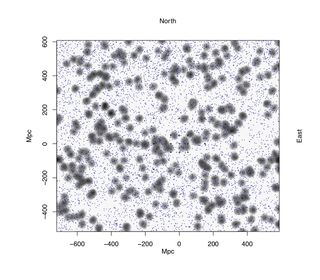
A newly discovered crescent of galaxies spanning 3.3 billion light-years is among the largest known structures in the universe and challenges some of astronomers' most basic assumptions about the cosmos.
The epic arrangement, called the Giant Arc, consists of galaxies, galactic clusters, and lots of gas and dust. It is located 9.2 billion light-years away and stretches across roughly a 15th of the observable universe.
Its discovery was "serendipitous," Alexia Lopez, a doctoral candidate in cosmology at the University of Central Lancashire (UCLan) in the U.K., told Live Science. Lopez was assembling maps of objects in the night sky using the light from about 120,000 quasars — distant bright cores of galaxies where supermassive black holes are consuming material and spewing out energy.
Related content: Cosmic record holders: The 12 biggest objects in the universe
As this light passes through matter between us and the quasars, it is absorbed by different elements, leaving telltale traces that can give researchers important information. In particular, Lopez used marks left by magnesium to determine the distance to the intervening gas and dust, as well as the material’s position in the night sky.
In this way, the quasars act "like spotlights in a dark room, illuminating this intervening matter," Lopez said.
In the midst of the cosmic maps, a structure began to emerge. "It was sort of a hint of a big arc," Lopez said. "I remember going to Roger [Clowes] and saying 'Oh, look at this.'"
Clowes, her doctoral adviser at UCLan, suggested further analysis to ensure it wasn't some chance alignment or a trick of the data. After doing two different statistical tests, the researchers determined that there was less than a 0.0003% probability the Giant Arc wasn't real. They presented their results on June 7 at the 238th virtual meeting of the American Astronomical Society.

But the finding, which will take its place in the list of biggest things in the cosmos, undermines a bedrock expectation about the universe. Astronomers have long adhered to what's known as the cosmological principle, which states that, at the largest scales, matter is more or less evenly distributed throughout space.
The Giant Arc bigger than other enormous assemblies, such as the Sloan Great Wall and the South Pole Wall, each of which are dwarfed by even larger cosmic features.
"There have been a number of large-scale structures discovered over the years," Clowes told Live Science. "They're so large, you wonder if they're compatible with the cosmological principle."
The fact that such colossal entities have clumped together in particular corners of the cosmos indicates that perhaps material isn’t distributed evenly around the universe.
But the current standard model of the universe is founded on the cosmological principle, Lopez added. "If we're finding it not to be true, maybe we need to start looking at a different set of theories or rules."
Lopez doesn't know what those theories would look like, though she mentioned the idea of modifying how gravity works on the largest scales, a possibility that has been popular with a small but loud contingent of scientists in recent years.
Daniel Pomarède, a cosmographer at Paris-Saclay University in France who co-discovered the South Pole Wall, agreed that the cosmological principle should dictate a theoretical limit to the size of cosmic entities.
Some research has suggested that structures should reach a certain size and then be unable to get larger, Pomarède told Live Science. "Instead, we keep finding these bigger and bigger structures."
Yet he isn't quite ready to toss out the cosmological principle, which has been used in models of the universe for about a century. "It would be very bold to say that it will be replaced by something else," he said.
Originally published on Live Science.
This 3-Billion Light-Year Long Galaxy Chain Could 'Overturn Cosmology'
'This is a very big deal.'
By Brad Bergan

Galaxies and stars in the night sky.ArtEvent ET / iStock
For a long time, scientists have thought the distribution of matter was evenly spread throughout the observable universe. It's the bedrock of cosmology. Or so we thought.
Researchers discovered a colossal arc of galaxies that spans an unconscionably vast distance of more than 3 billion light-years in a distant corner of the universe, according to a virtual briefing of the American Astronomical Society on June 7.
This could fundamentally "overturn cosmology as we know it," said Alexia Lopez, a cosmologist at the virtual briefing, in a Science News report. "Our standard model, not to put it too heavily, kind of falls through."
The 'Giant Arc' of touching galaxies would span twenty times the moon's width in the night sky
The "Giant Arc", as Lopez and her colleagues at the University of Central Lancashire in Preston, England call it, was observed via the studying of light from roughly 40,000 quasars, during the Sloan Digital Sky Survey. Quasars are thought to be nightmare-provokingly large supermassive black holes actively feeding at the center of a galaxy. And this massive feeding frenzy creates a light so bright that it can be seen at greater distances than almost any other phenomenon can. But while the quasar-borne light is in transit to Earth, some of it is absorbed by atoms in and around the galaxies in our relative foreground, in an aggregation of specific signatures in the light's pattern. And when it reaches astronomers' telescopes, they can tell.
The signature of the Giant Arc lies in magnesium atoms that've lost a single electron, while passing through the halos of galaxies roughly 9.2 billion light-years away. Interpolating the quasar light absorbed by the atoms, the astronomers uncovered a picture of a symmetrical curve of dozens of galaxies, stretching roughly one-fifteenth the radius of the entire observable universe. Obviously, this structure is invisible to the naked eye, but if we could see it in the night sky, the arc of interpenetrating galaxies would span roughly 20 times the full moon's width. Twenty times!
'Tantalizing' evidence for a 'Giant Arc,' but not convincing enough for some
"This is a very fundamental test of the hypothesis that the universe is homogeneous on large scales," said astrophysicist Subir Sarkar at the University of Oxford, who researchers colossal structures of the cosmos, but wasn't involved in the recent work, in the Science News report. If the Giant Arc of the distant universe is confirmed, "this is a very big deal." But Sarkar has doubts. "Our eye has a tendency to pick up patterns," and some people have even unswervingly bizarre claims, like seeing Stephen Hawking's initials written in fluctuations of the cosmic microwave background. This would make Stephen Hawking's initials as old as the oldest light in the universe. Which is absurd.
To determine the odds of galaxies lining up in such a gigantic cosmic march, Lopez executed three statistical tests, and all of them suggested it was no delusion. In fact, one of the tests surpassed the gold standard of physicists: when the chances of an observation being a statistical exception are less than 0.00003 percent. This is impressive, but not convincing enough for Sarkar. "Right now, I would say the evidence is tantalizing but not yet compelling," he said in the Science News report.
As Sarkar said, this is a big deal. But until additional observations are made to further confirm or falsify Lopez and colleagues' Giant Arc hypothesis, we shouldn't throw the whole of cosmology out the window. Even if it turns out to be a fluke, the reality of facing paradigm-shattering discoveries in modern astronomy is a testament to the staggering pace of the field.

















